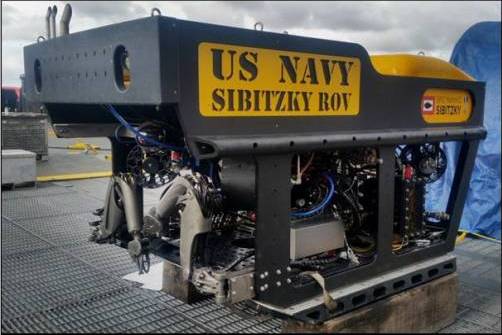Phoenix-built ROV Transferred by US Navy to Undersea Rescue Command

Phoenix International Holdings, Inc. was tasked by the Naval Sea Systems Command (NAVSEA) Office of the Director of Ocean Engineering, Supervisor of Salvage and Diving (SUPSALV) to design and build a Remotely Operated Vehicle (ROV) to conduct salvage operations to water depths of 2,000 feet of seawater (fsw).
The vehicle, originally named Hydros, went from a “blank piece of paper” to a completed ROV ready for at-sea testing within the span of 10 months. The ROV employs a robust aluminum inner frame encased in a black polymer outer frame. To support subsea recovery tasks, it is fitted with a lifting fixture capable of hoisting up to 1,000 pounds, two 5-function manipulators made of titanium, and a user friendly control system that employs programmable logic controller (PLC) technology with graphic user interface software capabilities.
 Soon after the ROV’s completion, representatives of the U.S. Navy’s Undersea Rescue Command (URC) and NAVSEA Submarine Escape & Rescue Program Office (PMS 391) were briefed on Hydros as a potential replacement for the Navy’s one-atmosphere diving system (ADS2000) for assessment of a disabled submarine, rescue hatch clearance, and attachment of the submarine rescue chamber’s downhaul cable. Subsequently, Phoenix personnel deployed with Hydros to San Diego to conduct at-sea demonstrations and acceptance trials. The vehicle successfully performed submarine rescue training tasks; including, inspecting a seafloor based submarine simulator, clearing debris, and attaching specialized rigging to the simulator. The success of this demonstration led the URC to request transfer of Hydros from SUPSALV to the U.S. Navy’s Submarine Rescue Program.
Soon after the ROV’s completion, representatives of the U.S. Navy’s Undersea Rescue Command (URC) and NAVSEA Submarine Escape & Rescue Program Office (PMS 391) were briefed on Hydros as a potential replacement for the Navy’s one-atmosphere diving system (ADS2000) for assessment of a disabled submarine, rescue hatch clearance, and attachment of the submarine rescue chamber’s downhaul cable. Subsequently, Phoenix personnel deployed with Hydros to San Diego to conduct at-sea demonstrations and acceptance trials. The vehicle successfully performed submarine rescue training tasks; including, inspecting a seafloor based submarine simulator, clearing debris, and attaching specialized rigging to the simulator. The success of this demonstration led the URC to request transfer of Hydros from SUPSALV to the U.S. Navy’s Submarine Rescue Program.
Following transfer approval, the URC renamed Hydros the “BM2 Sibitzky ROV” in honor of Boatswain Mate Second Class (BM2) Martin C. Sibitzky. After the sinking of USS Squalus (SS 192) in 1939 off the coast of Maine in 243 fsw, Navy Diver BM2 Sibitzky connected the downhaul cable to the submarine’s escape hatch. This action allowed the Submarine Rescue Chamber to reach the escape hatch and bring trapped sailors to the surface. Due to the heroism of BM2 Sibitzky and many others, 33 sailors were rescued from the downed submarine. Tragically, 26 sailors lost their lives. Today the Sibitzky ROV is undergoing final testing prior to becoming a permanent part of the Navy’s submarine rescue capability.
For more information, click here.

